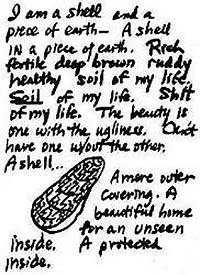 DRAW
A DREAM DRAW
A DREAM
After you have reviewed your dream in your mind's eye, draw the key images
that appeared. These might be people, animals, objects, places and scenes,
symbolic forms, or other visual impressions that stand out. (See the drawing
in the introduction to this chapter, page 136, for an example of a dream
drawing.)
Write in free-association about the images you have drawn. What comes to mind
when you look at each graphic image? What was its function in the dream? What
qualities does it have (in the dream or in real life)? What qualities in yourself
is it connected with? What do you feel or think about each image in your drawing?
Let the images in your dream drawing speak. Let them introduce themselves in the
first person, present tense, and tell about themselves. You may want to respond and
have a conversation. Write it all out as you would the script for a play.
Uses: This is an especially helpful technique for exploring fragmentary
dreams, the ones you don't recall in detail but from which a few isolated images,
events, or pieces of dialogue emerge. Here, you can focus on the pieces of the
puzzle you do remember. Putting your imagination to work through drawing and writing
can help you decode these symbols so you can find out what they mean to you personally
at this time in your life.
|

